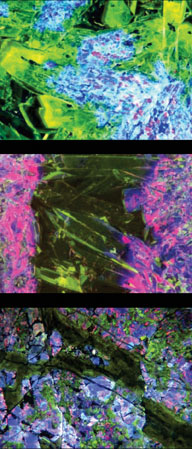|
News Notes
Minerals
Unlocking jade’s secrets
 Thousands
of years ago, an ancient Mesoamerican society carved sculptures from the
green-blue rock jade. Although recent expeditions to the region turned
up the jade’s geologic source — deep inside a fault — only
now have scientists begun to unlock the clues inside the stone that provide
a rare look at conditions deep inside Earth.
Thousands
of years ago, an ancient Mesoamerican society carved sculptures from the
green-blue rock jade. Although recent expeditions to the region turned
up the jade’s geologic source — deep inside a fault — only
now have scientists begun to unlock the clues inside the stone that provide
a rare look at conditions deep inside Earth.
To learn about the history of fluid inside a subduction zone, most researchers previously relied on indirect evidence such as the end-product rocks at Earth’s surface, which have been physically altered by volcanic activity. But Sorena Sorensen, a geochemist at the National Museum of Natural History in Washington, D.C., and colleagues say that jade, which forms from fluid tens of kilometers below Earth, provides a direct look at the fluid’s source and chemical evolution as it moved through rock.
When struck with a beam of electrons, jade luminesces in colors that represent its composition. Researchers can use that information to learn about the fluid deep inside subduction zones. Image is by Sorena Sorensen.
Until now, researchers were “speculating what happens at depth,” says Virginia Sisson, a jade expert associated with the American Museum of Natural History (AMNH) in New York City. “Here, we actually have an example of what’s happening,” she says. Because fluids at depth directly affect the shaping of features at Earth’s surface, “this is a big deal for people interested in the cycling of elements, as well as what goes on in the mantle and making volcanoes,” she says.
The heart of Sorensen’s team’s investigation goes back 3,000 years to Guatemala, where people of the Olmec culture sculpted the region’s rare blue-green rock. In 2001, expeditions, of which Sisson was part, to the region culminated in the discovery of jade-bearing rocks the size of houses (see Geotimes, August 2002).
Following the discovery of the Guatemalan jade source, researchers started looking into how it formed. Most scientists agreed that it formed within the region’s Motagua Fault, but details about how it formed remained a mystery.
Sorensen and colleagues’ new research, published in the July American Mineralogist, provides evidence that jade forms when hydrothermal fluids stream through open cracks and deposit the mineral’s requisite elements within massive veins. Sorensen looked at the microscopic structure of hundreds of samples from the Guatemalan region and five other jade-producing regions around the world. Bombarding the samples with a stream of electrons causes jade to luminesce “spectacularly,” Sorensen says, in colors ranging from blue and red to yellow and green, which reflect various stages of jade’s chemical formation.
At the earliest stage in subduction zones, elements combine and crystallize into blue and red luminescing jade. As new elements enter the mix, the jade becomes yellow-green. The final crystallizing stage (not all make it that far) forms the rare, yet most familiar, green jade. By combining observations of these colors, which indicate the presence of specific elements, with oxygen isotope analysis, Sorensen was able to hone in on possible sources of jade-creating fluid.
The analysis revealed different fluids that correspond to three different sources: one apparently altered by seawater, another that stems from rocks altered by a high-temperature hydrothermal system, and another that comes from a mantle source. Sorensen’s research shows that “a lot of elements that people think don’t really move, are moving,” Sisson says.
Still unknown, however, are details about the precise depth of jade formation, Sisson says. Another question remains about how the jade, once formed, actually makes it from the depths of subduction zones to Earth’s surface.
The original team that discovered the jade would like to return to Guatemala to investigate reports of jade beyond the currently known extent of about 150 kilometers along the Motagua Fault. “It’s just really widespread,” Sisson says. “Every time we go down there, we find new [deposit] localities farther and farther away from the main source.”
Kathryn Hansen
Links:
"Guatemala's Olmec Jade,"
Geotimes, August 2002

 Subscribe
Subscribe

